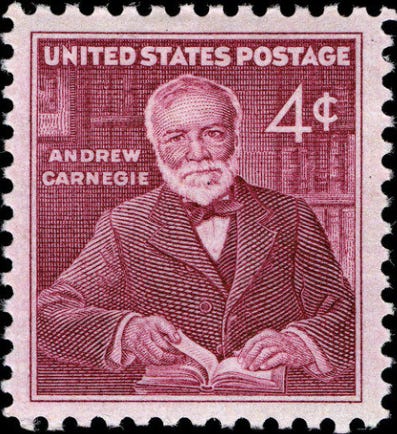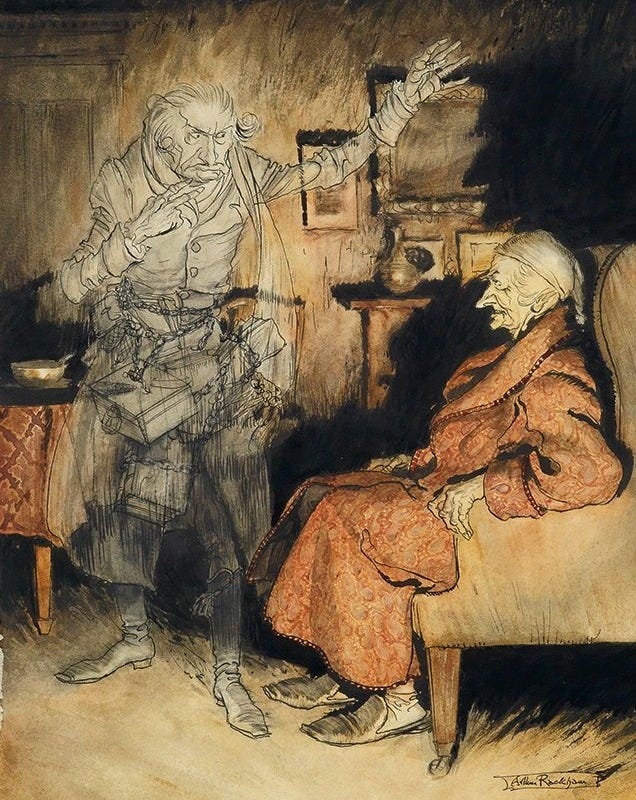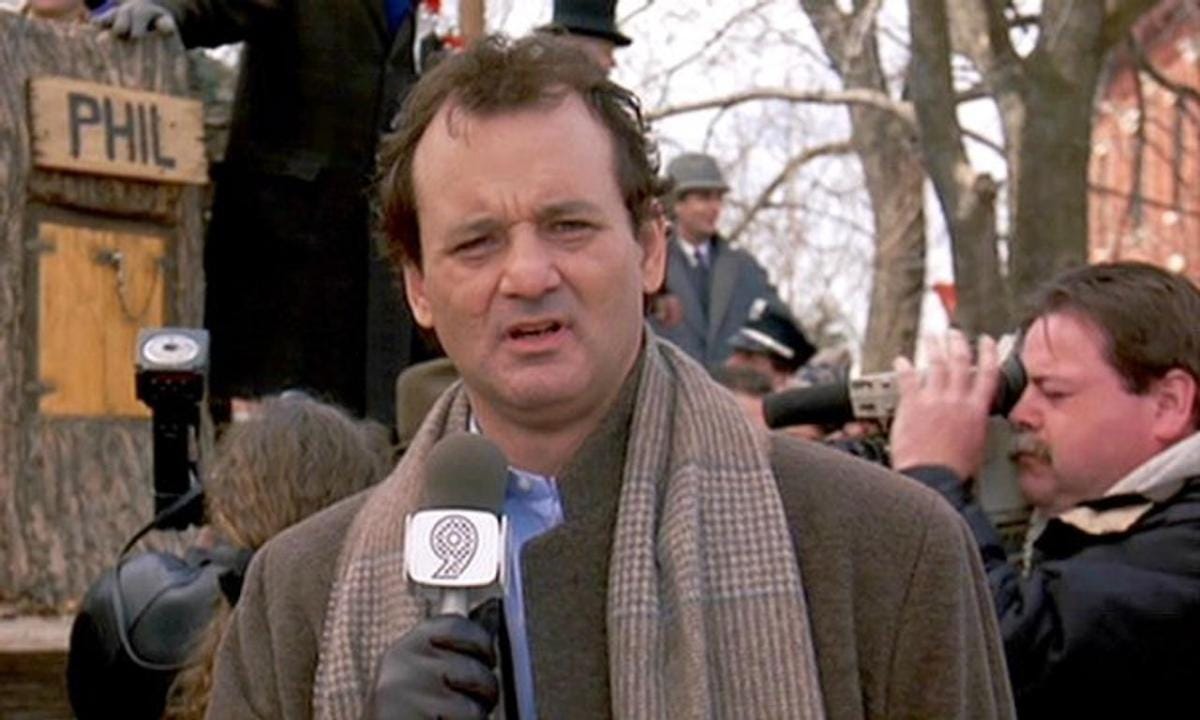Inspiring the self-server to self-sacrificer transition in fiction, part 2
The examples of Andrew Carnegie (real life), Ebenezer Scrooge (A Christmas Carol), and Phil Conners (Groundhog Day)
(If you like this post, selecting the ❤️ to bless the Algorithm Angels.)
In Inspiring the transition from self-server to self-sacrificer, part 1, we saw that the discontents of the self-server pattern often lead to a tragic fall, from which there might also be a redemption. Even with redemption, however, characters merely end up back where they started: they haven’t grown further into the self-sacrificer pattern because something is still missing. Indeed, the anguishing monotony of yo-yoing between self-server and self-comforter eventually compels one to seek an alternative. But what is it?
Intuitively, we understand in our souls that lasting fulfillment comes through increasing levels of self-expansion—union with the Infinite, Eternal, Absolute of God requires expansion to infinity. What self-servers struggle to understand is that this “self-expansion” has nothing to do with how much power, glory, or wealth they draw to themselves: being finite, it’s simply never enough. Nor does self-expansion have anything to do with how others behave or what others possess that they cannot.
The limitations that self-servers encounter in their quest for fulfillment are due solely to their own narrow sense of self, which is to say, a contractive ego. This contractive ego is the “self” that must be sacrificed in order to experience greater fulfillment. Self-servers must eventually realize that serving oneself just isn’t enough and resolve instead to focus their talents, creative energies, and resources more on serving others and/or serving some cause.
This resolution marks the transition into the pattern of the self-sacrificer. As with the self-comforter to self-server transition, the transition to self-sacrificer may still not involve any explicit thought of “seeking God.” Nevertheless, the transition is upwards on the spectrum of behavioral patterns toward God/Satchidananda and is therefore a spiritual direction.
The examples of Rockerfeller, Carnegie, and Scrooge
Two real-world examples of this transition can be found in the lives of John D. Rockefeller and Andrew Carnegie, the two wealthiest industrialists of The Gilded Age in the United States and two of the richest persons in all of history.1 For much of their careers they subscribed rigidly to the idea of Social Darwinism, believing that “all growth must occur at the top, and [in order to] do so, they must waste no strength in the vain task of trying to uplift the weak.”2 They thus had no qualms about building enormous personal fortunes by exploiting others whom they considered lesser or weaker than themselves (an approach known as Taylorism).
Yet, as they grew old and faced the truth of their mortality, they began to rethink their role in society and their relationship to the less fortunate. As Carnegie himself wrote in The Gospel of Wealth:
This, then, is held to be the duty of the man of Wealth: … becoming the mere agent and trustee for his poorer brethren, bringing to their service his superior wisdom, experience, and ability to administer, doing for them better than they would or could do for themselves… [millionaires are] entrusted for a season with a part of the increased wealth of the community, but administering it for the community far better than it did, or would have done, of itself.3
Growing past his manipulative, self-server pattern, Carnegie became one of the greatest philanthropists of all time, funding many libraries, universities, and public venues. These actions, which many other wealthy people have followed, demonstrate a rise into the pattern of the self-sacrificer, which the US Postal Service found worthy of commemoration.4

Such transitions, often variations on “The Man Who Learned Better” story type, are also frequent plotlines in fiction. The best-known example is probably Dickens’ A Christmas Carol in which Ebenezer Scrooge is given, thanks to the intervention of his former business partner, Jacob Marley, the opportunity to see the natural consequences of his pattern of behavior before he is forced to suffer them in the afterlife as Marley does. Marley explains the need thus:
“It is required of every man…that the spirit within him should walk abroad among his fellowmen, and travel far and wide; and if that spirit goes not forth in life, it is condemned to do so after death. It is doomed to wander through the world—oh, woe is me!—and witness what it cannot share, but might have shared on earth, and turned to happiness! … I wear the chain I forged in life…I made it link by link, and yard by yard; I girded it on of my own free will, and of my own free will I wore it.” (Pages 23-24 of the AmazonClassics Kindle Edition)

When Scrooge compliments Marley on his business acumen in life, Marley retorts:
“Business!” cried the Ghost, wringing its hands again. “Mankind was my business. The common welfare was my business; charity, mercy, forbearance, and benevolence, were, all, my business. The dealings of my trade were but a drop of water in the comprehensive ocean of my business!” (26)
Marley’s intervention on Scrooge’s behalf, which is followed by that of the three spirits, shows Scrooge the natural outcome of his selfishness, giving him the chance to reform before it’s too late, to step out of the self-server pattern into that of the generous, open-hearted self-sacrificer. And who would doubt that that change is another step upwards toward the Divine?
For more details, refer to my post, The fictional character I would most like to be, where I make the case (though I didn’t use the terminology I’m using here) that Scrooge, in his essential nature, was not, in fact, that of a self-server but rather that of a loving self-sacrificer who happens to have fallen into that of the self-server. That fall is shown through his experiences with the Ghost of Christmas Past. His experiences with the other two ghosts then guide him through the process of redemption. I argue, too, that Scrooge also makes the further transition in the story’s denouement to a self-transcender, but you can read that other post for details.
My favorite example: Groundhog Day
The 1992 movie, Groundhog Day, provides an excellent demonstration of the transition from self-server to self-sacrificer. It also clearly shows the consequences of looking for fulfillment in the wrong places.
The story’s protagonist, Phil Conners (played brilliantly by Bill Murray), is a cynical, vain, and self-centered TV weatherman who, for reasons that are never explained, gets stuck in an endless loop of reliving the same day, Groundhog Day (February 2nd), over and over. To exacerbate his suffering, he gets to live that repeating day in the very heart of Groundhog Day celebrations, Punxsutawney, Pennsylvania, a place that he despises.
As the story opens, Phil is disgusted at having to go to Punxsutawney, for the fourth year in a row, to report on Groundhog Day, February 2nd. Though he tries to do the job as quickly as possible and hurry back to Pittsburgh, he’s thwarted by a huge snowstorm that he wrongly predicted would miss the region, He’s thus forced to stay in the small town that is populated, in his mind, with “hicks.”
Phil awakens the next morning to discover, to his great confusion, that it’s still Groundhog Day. He freaks out even more when the day repeats a second time. Soon, though, as in the video clip below, he realizes that because his actions have no consequences—he essentially gets a free do-over every day—he might as well take advantage of it.
He thus begins a quest for fulfillment through the strategies of both self-comforter (sex) and the self-server (money), along with trying to seduce his producer, Rita (played by Andie MacDowell). Nothing works, however, which is hilariously highlighted by a montage of Rita repeatedly spurning his advances by slapping him across the face.5
Broken and depressed, Phil sinks to rock bottom and decides to end it all. Yet even here, in a reflection of the doctrine of reincarnation, his multiple suicides offer no escape: each time he awakens once again on Groundhog Day, “without a scratch on me, without a dent in the fender.”
Eventually he comes to understand two attitudes of the self-sacrificer. First is that even though his actions have no outer consequences, they have inner consequences, such as the depression that led him to repeated suicides. He also learns that what really matters to him—and what will ultimately win Rita—is not what he receives, but what he gives.
Phil thus sets out on a program of not only of self-improvement but of service—moral living, in other words. As director Harold Ramis said, “He becomes the god of the town,” appearing in just the right places at just the right times to prevent others’ suffering. He’s not omnipotent, though, which he learns by his inability to prevent an old man from passing away. But he can at least prevent him from passing away alone.
In the end, Phil finally reaches the level of excellence and selfless love that wins Rita: he wakes up on February 3rd with her beside him. And whereas he so despised Punxsutawney at the beginning, the movie ends with him saying to Rita, “Let’s live here” (with the humorous tag, “We’ll rent to start”).
Phil Conners’ whole arc, then, begins with him as a solid self-server. When he feels trapped, he descends into the self-comforter pattern, even to the depths of self-destruction. But being thwarted even there, as happens for every soul across however many lives they must live, he finally accepts that his only option is to rise higher. Recovering himself and knowing that neither the self-comforter nor the self-server approach will work, he thus chooses to grow into the pattern of the self-sacrificer, letting go his ego, his vanity, and his self-importance. And if we allow that Rita symbolizes not just excellence but a Divine Beloved, then Phil even begins to touch the level of the self-transcender.
This complete arc is why people of many faiths said to director Harold Ramis, “You made a movie about my religion.” For what else is the purpose of true religion but self-transcendence?
Coming up in part 3
Part 3 will complete our examination of the self-server to self-sacrificer transition with the general pattern for such stories and then wrap up with a few other observations.
(Continued in part 3)
(If you like this post, selecting the ❤️ to bless the Algorithm Angels.)
They are both runners-up to the king of 14th-century Mali, Mansa Musa I, of whom we know relatively little but is widely recognized as the wealthiest person in all of history.
Joseph Locke and Ben Wright, The American Yawp, Stanford University Press, 2019.
From https://www.carnegie.org/about/our-history/gospelofwealth/, eighth paragraph from the bottom.
Bill Gates is another modern example, but his story is not yet over. He left his intensely competitive life at Microsoft (where I personally encountered him from time to time during my career there) to start the Gates Foundation. As I was writing this post, too, Gates announced that he would give away nearly all his remaining fortune over the next 20 years.
Bill Murray asked Andie MacDowell to slap him for real each time, to add authenticity.





